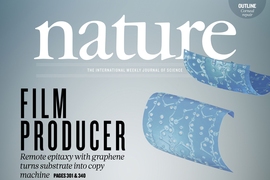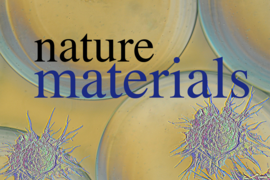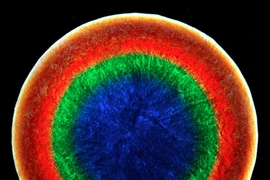Producing images powerful enough to be selected for the covers of major research journals is nothing new for Felice Frankel: She’s being doing it for decades with great success. But now, she’s extending that approach, using a growing arsenal of visual tools and techniques as she works with scientists and engineers to develop imagery that illustrates their concepts.
Frankel, a research scientist in MIT’s Center for Materials Science and Engineering, has helped to produce images that in the last few months have graced the covers of Nature, Nature Materials, and Environmental Science, among others. Some of her work is also featured in the exhibit “Images of Discovery: Communicating science through photography,” running at the MIT Museum through this August.
Frankel started her career in science and then turned to photographing architecture and landscapes, publishing a few books along the way. She started working with MIT scientists to improve their visual communications back in the ’90s. She’s been expanding her work ever since, both developing new ways of communicating ideas visually and teaching techniques for doing so.
Her latest work has involved combining a variety of photographic images into photo-illustrations that help to explain a process better than individual photos could. The latest journal covers have been examples of this approach. “I take pieces of photos I’ve already made and put them together as an illustration,” she says.
The cover image she created for the April 20 issue of Nature is a perfect example of this process. The research being illustrated involved using graphene as a kind of “copy machine” for nanopatterned thin sheets, for electronics applications. Instead of using just photographic images of the patterned surfaces, which wouldn’t have conveyed much information about the process, or a stand-alone diagram that wouldn’t have seemed as real, she combined the two elements into a single illustration.
It took many steps to produce the image elements and combine them effectively, but the result is a montage that clearly embodies the key elements of the process: the graphene surface and the thin sheets picking up patterns from that surface, one after another. And by mimicking the appearance of a copying machine with copies flying off from it, the final image conveys the active process of cranking out many identical copies from a single surface.
The process of creating the image involved many discussions and iterations among Frankel, the researcher, and the creative director at Nature, she recalls. The creative director “saw the potential” even from early sketches of the proposed design, Frankel says, and helped to refine the design into something that both the researcher and the journal’s editors could agree on.
“Every situation is different,” Frankel says. But the common thread is “helping to bring attention to important work,” by creating images that combine important concepts with an eye-catching design that can attract readers who might otherwise have overlooked the paper or related news coverage. She says the heads of several MIT departments have been encouraging their younger researchers to seek out her assistance, to help them gain attention for their work while their careers are getting off the ground.
“I first collaborated with Felice as a junior faculty member, and some of the core images that she worked on with us ended up being cover articles with meaningful impact over the years,” says Paula Hammond, the David H. Koch Professor of Engineering and head of the Department of Chemical Engineering. “I have encouraged my own research group members, and now faculty members and the students and postdocs in our department, to take part in the workshops and courses that she offers to teach others about the key issues of communicating science through images.”
Frankel “is one of the hidden jewels at MIT,” says Anette “Peko” Hosoi, a professor and associate department head of mechanical engineering. “She has a deep understanding of the importance of visual communication and a true talent for bringing scientific concepts to life. I constantly call on her for advice, and she has fundamentally changed the way I think about my research.”
Another example of Frankel’s recent work, which also involved combining multiple photos into a single illustration, was a cover for the June issue of Nature Materials, for a paper that described how certain cells respond to biomaterials. The resulting image was, in essence, “a complete metaphor.” Although it depicted something that did not exist, it clearly conveyed the effect being described in the paper: a technique that prevents macrophages, a type of white blood cells that act as a kind of molecular garbage collector, from creating unwanted deposits around devices implanted in the body such as pacemakers.
To produce that cover, Frankel combined a backround image from the researchers’ lab, depicting normal cells in a growth medium, along with a foreground image depicting a macrophage, which Frankel found after an online search and then manipulated after purchasing rights to the image. The combination suggested the interactions described in the research, even though those interactions had not been directly imaged.
When she sits down with researchers to discuss images for their work, Frankel says, “I encourage them to come up with metaphors” that can help to show the essence of their work in ways that a simple photographic image might not. “Thinking about coming up with metaphors is also a means of clarification” that can help the researchers describe what they’ve done more clearly to people outside their own discipline.
Besides working one-on-one with researchers, Frankel has also led several workshops and developed an online edX class to convey her ideas about how to use visual imagery to enhance scientific understanding. The tutorials are also available on Open CourseWare.
Frankel “has done a fabulous job in helping our researchers to deliver their research graphically,” says Gang Chen, head of the department of mechanical engineering. “She is creative and resourceful, and is a delight to work with.”
In her direct work with the researchers, Frankel urges them to “tell me the salient facts,” and then they can work together on “designing an image to represent the fundamental aspects of what the research is about.” And, she says, “it’s another way for the researchers to clarify in their own minds” the key points they need to communicate.











